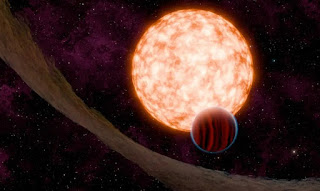What Secrets Can the Universe’s Youngest Exoplanet Reveal?
Have you ever wondered how planets come into existence, or what we might learn from observing their earliest moments? In a groundbreaking discovery, astronomers have identified the youngest transiting exoplanet ever observed, orbiting a star that is merely 3 million years old. This incredible finding offers a front-row seat to the earliest stages of planetary development, unveiling insights that were once beyond our reach. Dive in with us at FreeAstroScience.com, where we simplify the cosmos, as we explore the implications of this discovery and how it could redefine our understanding of planetary evolution.
The Discovery: A New Benchmark in Exoplanet Science
The newly discovered planet, IRAS 04125+2902 b, orbits a star in the Taurus Molecular Cloud. This star, just 3.3 million years old, is over three times younger than any previously known star hosting a transiting planet. Planets form from the protoplanetary disks of gas and dust surrounding young stars, and this discovery sets an earlier benchmark for observing such processes.
This exoplanet is a gas giant with a radius slightly smaller than Jupiter’s, but its mass is only 30% that of Jupiter. Over time, it is expected to shrink and stabilize into a smaller, denser configuration akin to Saturn or Neptune. Observations like these challenge long-standing assumptions about the timeline of planetary formation and provide a rare glimpse into the earliest phases of planetary life.
Why Transit Observations Matter
The planet's discovery is particularly exciting because it transits, or passes in front of its host star, relative to our viewpoint. This method of observation provides an abundance of data:
- Size and Orbital Period: Transit timing and dimming reveal the planet's size and its orbital period of just 8.83 days.
- Atmospheric Composition: Light passing through the planet’s atmosphere during transit can reveal its chemical makeup, a vital clue for understanding planetary development.
Unlike other detection methods, transit observations allow researchers to piece together a more complete picture of an exoplanet's characteristics.
A Hot and Chaotic Environment
IRAS 04125+2902 b is situated close to its host star, experiencing intense heat. This proximity, combined with the residual heat from its gravitational collapse, makes it an excellent candidate for studying how extreme environments shape young planets.
Adding to the intrigue, the planet's protoplanetary disk is tilted at a 30-degree angle relative to the planet's orbital plane. This unusual alignment might be due to gravitational influences from companion stars, though its exact cause remains a mystery.
The Youngest Known Window into Planetary Formation
Previously, young stars with detected planets ranged between 10 to 40 million years old. IRAS 04125+2902 b, however, smashes this record, providing an unprecedented opportunity to study planets forming within the first few million years. Observing such systems offers:
- Evolutionary Insights: The chance to track how planetary structures evolve over time.
- Atmospheric Development: A deeper understanding of how atmospheric components form under intense radiation and heat.
Looking Forward: The Scientific Potential
At approximately 521 light-years away, IRAS 04125+2902 b isn’t the closest exoplanet to Earth, but it’s relatively accessible compared to other young systems. Its proximity opens the door for further observations with advanced telescopes like the James Webb Space Telescope, which could probe its atmosphere and surface conditions in detail.
Studying such young exoplanets isn’t just about understanding them—it’s also about placing our own solar system in context. Insights into these celestial infants could answer fundamental questions about Earth’s formation and the potential for life elsewhere.
Conclusion: The Dawn of Planetary Discovery
IRAS 04125+2902 b represents a new frontier in exoplanetary science. By studying such a young and dynamic system, we not only uncover the processes that shape planets but also expand our understanding of the cosmos. At FreeAstroScience.com, we’re dedicated to making these discoveries accessible and fascinating.
This exoplanet reminds us of the beauty and complexity of the universe—and how much we still have to learn. As we peer into the past of this distant world, we’re also glimpsing the story of our own origins.
Stay curious, and let the stars guide us to answers yet undiscovered!


Post a Comment